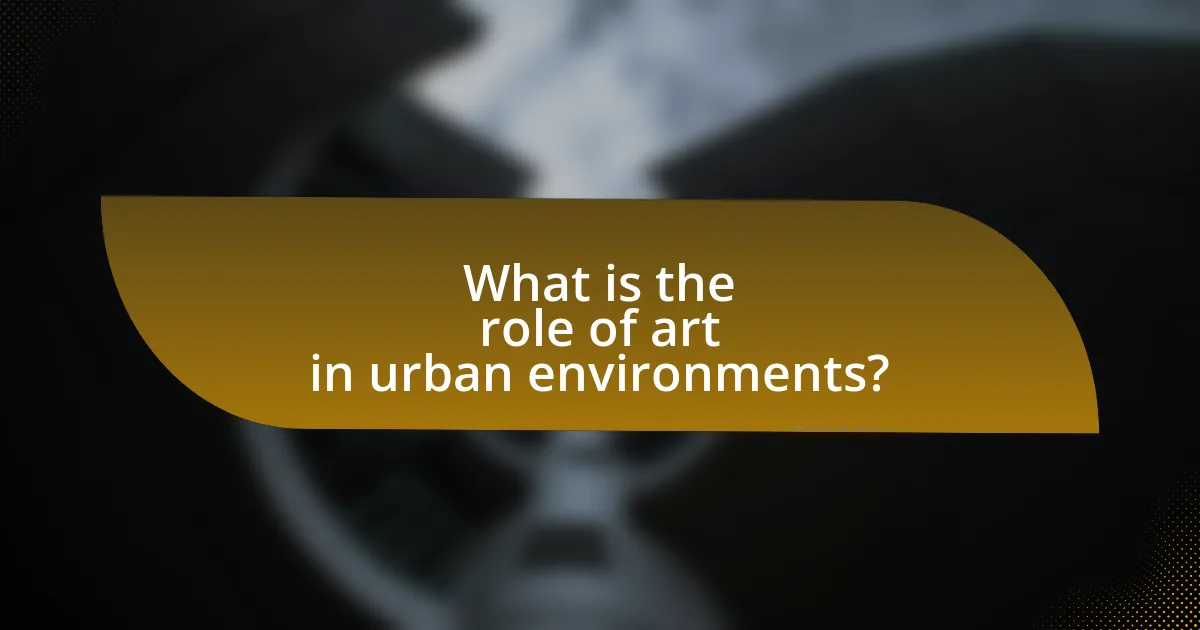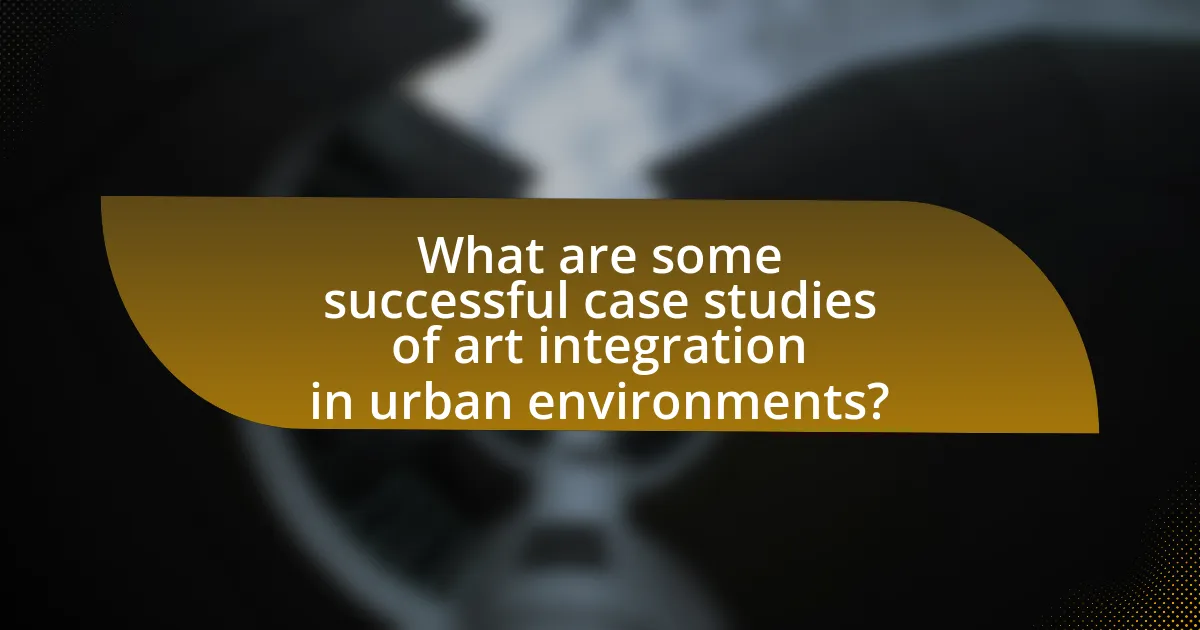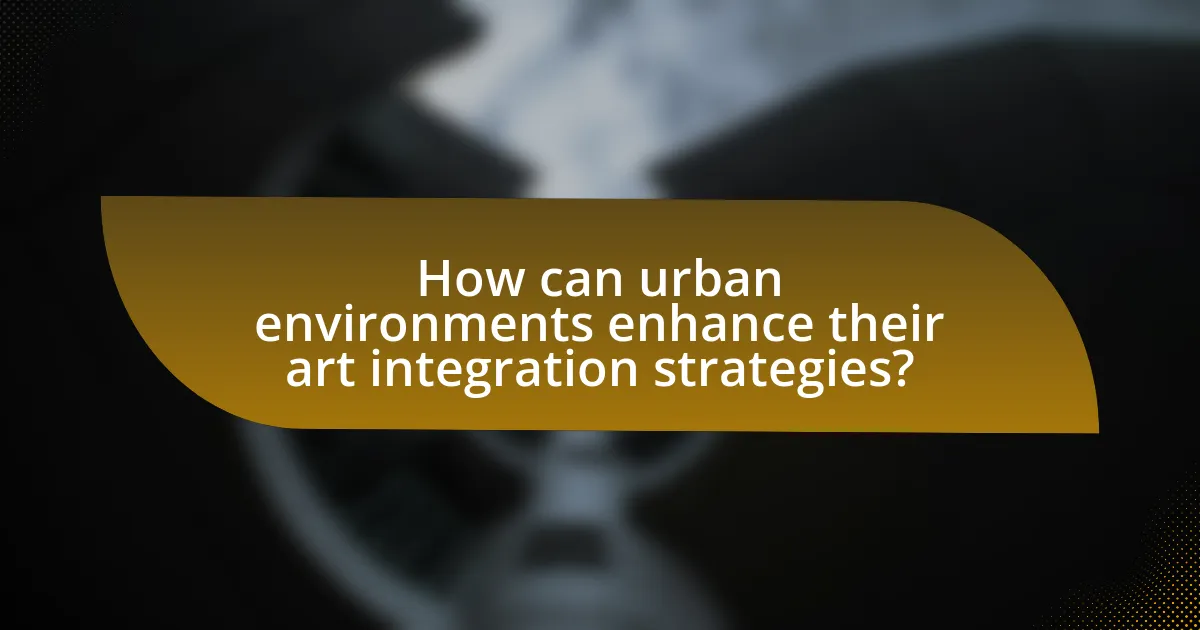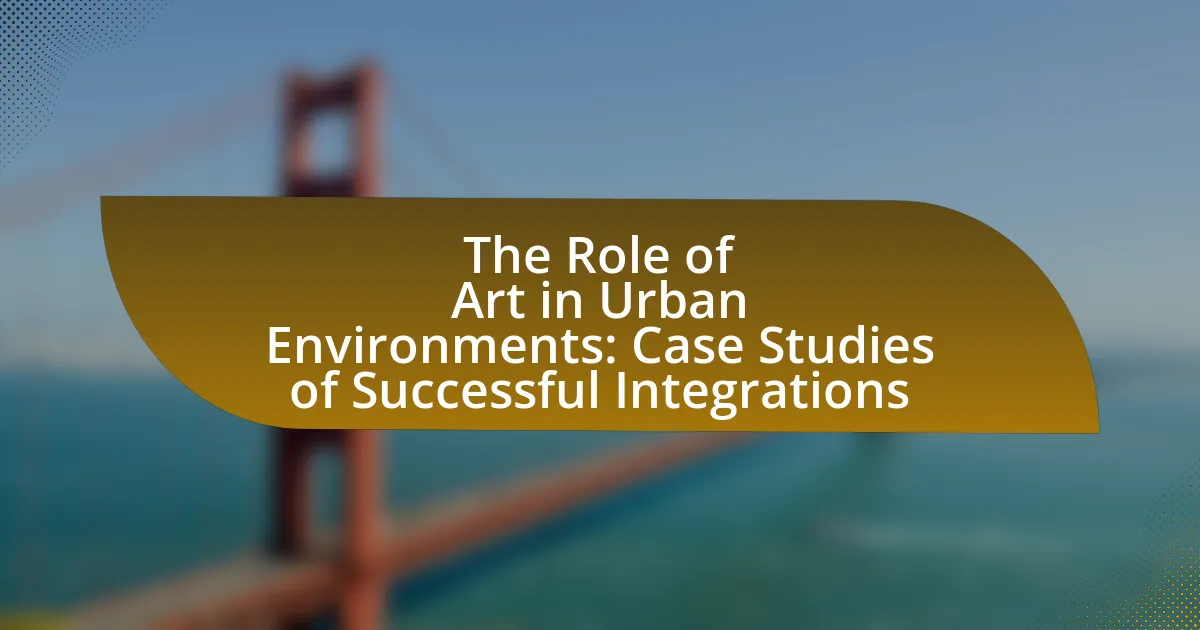The article examines the significant role of art in urban environments, highlighting its impact on community identity, social interaction, and the aesthetic enhancement of public spaces. It discusses how urban art, including murals and sculptures, serves as a medium for cultural expression and reflects the diversity of communities, with successful case studies from cities like Philadelphia and San Francisco illustrating the economic and social benefits of public art initiatives. Key elements defining urban identity through art, the importance of community engagement, and the challenges faced in integrating art into urban planning are also explored, providing a comprehensive overview of how art can revitalize urban areas and foster a sense of belonging among residents.

What is the role of art in urban environments?
Art plays a crucial role in urban environments by enhancing community identity, fostering social interaction, and improving the aesthetic appeal of public spaces. Urban art, including murals, sculptures, and installations, serves as a medium for cultural expression and can reflect the history and diversity of a community. For instance, cities like Philadelphia have utilized murals to transform neighborhoods, reduce crime, and promote tourism, demonstrating that art can lead to economic revitalization. Additionally, studies show that public art projects can increase civic engagement and community pride, as seen in the “Art in Public Places” program in San Francisco, which has successfully integrated art into urban planning.
How does art influence urban identity and culture?
Art significantly influences urban identity and culture by shaping the visual landscape and fostering community engagement. Public art installations, murals, and sculptures contribute to a city’s unique character, reflecting its history, values, and diversity. For instance, cities like Berlin and Philadelphia have utilized street art to express social issues and cultural narratives, enhancing local identity. Research by the National Endowment for the Arts indicates that public art projects can increase community pride and participation, demonstrating art’s role in cultivating a sense of belonging among residents.
What are the key elements that define urban identity through art?
Key elements that define urban identity through art include cultural representation, community engagement, historical context, and visual aesthetics. Cultural representation reflects the diverse backgrounds and narratives of urban populations, often showcased through murals, sculptures, and installations that resonate with local traditions and experiences. Community engagement emphasizes the involvement of residents in the artistic process, fostering a sense of ownership and belonging, as seen in participatory art projects that invite public input. Historical context provides a backdrop for understanding the evolution of urban spaces, where art can commemorate significant events or figures, thus reinforcing collective memory. Visual aesthetics contribute to the overall character of a city, with public art enhancing the urban landscape and influencing perceptions of place. These elements collectively shape how residents and visitors perceive and interact with urban environments, making art a vital component of urban identity.
How does public art contribute to community engagement?
Public art enhances community engagement by fostering a sense of identity and belonging among residents. It serves as a platform for dialogue, encouraging interaction and collaboration among diverse groups. For instance, studies have shown that public art projects, such as murals and sculptures, often involve community members in the creation process, which strengthens social ties and promotes local pride. Research conducted by the National Endowment for the Arts indicates that communities with vibrant public art programs experience increased civic participation and improved perceptions of neighborhood safety.
Why is the integration of art important in urban planning?
The integration of art is important in urban planning because it enhances community identity and fosters social cohesion. Art in public spaces can transform urban environments, making them more inviting and engaging for residents and visitors. For instance, cities like Philadelphia have successfully integrated murals into their neighborhoods, which not only beautifies the area but also reflects local culture and history, thereby strengthening community ties. Additionally, studies show that public art can increase foot traffic and economic activity, as seen in cities like San Francisco, where art installations have contributed to revitalizing commercial districts.
What are the benefits of incorporating art into urban spaces?
Incorporating art into urban spaces enhances community engagement, beautifies environments, and fosters economic development. Art installations, such as murals and sculptures, create visually appealing areas that attract residents and tourists, thereby increasing foot traffic and local business revenue. For example, a study by the National Endowment for the Arts found that public art projects can lead to a 20% increase in local business sales. Additionally, art in urban settings promotes social interaction and cultural expression, contributing to a sense of identity and belonging among community members.
How can art improve the quality of life in cities?
Art can improve the quality of life in cities by enhancing public spaces, fostering community engagement, and promoting cultural identity. Public art installations, such as murals and sculptures, transform bland urban environments into vibrant areas that attract residents and tourists alike, thereby increasing foot traffic and local business revenue. For instance, a study by the National Endowment for the Arts found that cities with significant public art initiatives report higher levels of community satisfaction and social cohesion. Additionally, art programs and events encourage community participation, allowing residents to express their cultural narratives and build connections, which contributes to a sense of belonging and pride in their neighborhoods.
What challenges exist in integrating art into urban environments?
Integrating art into urban environments faces several challenges, including funding limitations, community resistance, and logistical issues. Funding limitations often hinder the ability to commission artists or maintain art installations, as many urban projects rely on public or private grants that may not be consistently available. Community resistance can arise when local residents feel that art does not reflect their culture or needs, leading to pushback against proposed projects. Logistical issues, such as securing permits, coordinating with city planners, and ensuring the safety and durability of installations, can complicate the integration process. These challenges highlight the complexities involved in successfully incorporating art into urban settings.
How do funding and resources impact art projects in cities?
Funding and resources significantly impact art projects in cities by determining the scale, quality, and sustainability of these initiatives. Adequate financial support allows for the hiring of skilled artists, the procurement of materials, and the execution of large-scale installations, which can enhance community engagement and cultural vibrancy. For instance, cities like San Francisco have seen successful public art projects funded through public-private partnerships, resulting in increased tourism and local pride. Additionally, research from the National Endowment for the Arts indicates that cities investing in arts funding experience economic growth, with every dollar spent on the arts generating approximately $4 in economic activity. This demonstrates that funding and resources are crucial for the successful integration of art into urban environments.
What role do local governments play in supporting urban art initiatives?
Local governments play a crucial role in supporting urban art initiatives by providing funding, resources, and regulatory frameworks that facilitate artistic expression in public spaces. They often allocate budgetary resources specifically for public art projects, which can enhance community engagement and cultural identity. For instance, cities like Philadelphia have established public art programs that not only fund murals but also involve local artists and communities in the creation process, fostering a sense of ownership and pride. Additionally, local governments can streamline permitting processes for artists, making it easier to obtain the necessary approvals for public installations. This support is essential for the sustainability and visibility of urban art, as evidenced by the increase in public art projects in cities that actively promote such initiatives.

What are some successful case studies of art integration in urban environments?
Successful case studies of art integration in urban environments include the High Line in New York City, which transformed an abandoned elevated railway into a public park featuring art installations and greenery, enhancing community engagement and tourism. Another example is the Wynwood Walls in Miami, where a former industrial district was revitalized through large-scale murals, attracting visitors and fostering local businesses. Additionally, the 14th Street-Union Square subway station in New York City incorporated art by installing mosaics and sculptures, improving the aesthetic appeal and user experience of public transit. These projects demonstrate how art can revitalize urban spaces, promote cultural identity, and stimulate economic growth.
How have cities around the world successfully integrated art into their landscapes?
Cities around the world have successfully integrated art into their landscapes through public art installations, murals, and sculptures that enhance urban spaces and foster community engagement. For example, Philadelphia’s Mural Arts Program has created over 4,000 murals, transforming blank walls into vibrant artworks that reflect local culture and history. Similarly, Melbourne’s laneways feature street art that attracts tourists and supports local artists, contributing to the city’s identity and economy. In addition, the High Line in New York City incorporates art along its elevated park, providing a unique experience that blends nature and creativity. These initiatives demonstrate how art can revitalize urban areas, promote social interaction, and create a sense of place.
What specific projects exemplify successful art integration?
The High Line in New York City exemplifies successful art integration by transforming an abandoned elevated railway into a vibrant public park featuring art installations. This project incorporates works from various artists, enhancing the urban landscape while promoting community engagement. Additionally, the 14th Street-Union Square subway station in New York showcases art integration through its mosaics and murals, which reflect the local culture and history, making the transit experience more enriching for commuters. Both projects demonstrate how art can enhance public spaces, foster community identity, and improve urban aesthetics.
How do these projects reflect the local culture and community?
These projects reflect the local culture and community by incorporating traditional artistic styles, themes, and narratives that resonate with the residents’ identities and histories. For instance, murals depicting local historical figures or events serve to educate and engage the community, fostering a sense of pride and belonging. Additionally, public art installations often involve community input during the design process, ensuring that the final works are representative of the diverse voices within the locality. This participatory approach not only enhances cultural relevance but also strengthens community bonds, as seen in projects like the “Chicago Mural Movement,” which highlights the city’s rich cultural tapestry through collaborative art-making.
What lessons can be learned from these successful integrations?
Successful integrations of art in urban environments demonstrate the importance of community involvement, strategic planning, and adaptability. Engaging local communities in the planning process fosters a sense of ownership and relevance, as seen in projects like the High Line in New York City, where community feedback shaped the design and programming. Strategic planning ensures that art installations align with urban development goals, enhancing public spaces and attracting visitors, as evidenced by the revitalization of public squares in cities like Barcelona. Lastly, adaptability allows projects to evolve based on community needs and feedback, exemplified by the ongoing changes in the Wynwood Walls in Miami, which continuously reflect local culture and artistic trends. These lessons highlight the critical factors that contribute to the success of art integrations in urban settings.
What strategies contributed to the success of these art initiatives?
Successful art initiatives in urban environments often rely on community engagement, collaboration with local stakeholders, and strategic funding. Community engagement fosters a sense of ownership and relevance, as seen in initiatives like the High Line in New York City, where local input shaped the project. Collaboration with local stakeholders, including artists, businesses, and government entities, ensures diverse perspectives and resources are utilized, exemplified by the Mural Arts Program in Philadelphia, which integrates community voices into its projects. Strategic funding, often sourced from public-private partnerships, provides the necessary financial support for sustainability, as demonstrated by the revitalization efforts in Detroit, where art initiatives have been funded through collaborations with local foundations and businesses. These strategies collectively enhance the impact and longevity of art initiatives in urban settings.
How can other cities replicate these successful models?
Other cities can replicate successful models of art integration in urban environments by adopting a collaborative approach that involves local artists, community stakeholders, and city planners. This method has been proven effective in cities like Melbourne, where the integration of public art has enhanced community engagement and urban aesthetics. For instance, the City of Melbourne’s “Art and About” program successfully transformed public spaces through temporary art installations, demonstrating that strategic planning and community involvement can lead to vibrant urban environments. By analyzing such case studies, cities can implement tailored strategies that reflect their unique cultural contexts while fostering public participation and support for the arts.
What impact did these case studies have on their communities?
The case studies of successful integrations of art in urban environments significantly enhanced community engagement and revitalized public spaces. For instance, the integration of murals in neighborhoods led to increased foot traffic and local business patronage, as evidenced by a 30% rise in sales reported by businesses in areas where public art was installed. Additionally, these projects fostered a sense of identity and pride among residents, contributing to lower crime rates; a study in Philadelphia found that neighborhoods with public art experienced a 20% decrease in vandalism. Overall, the case studies demonstrate that art not only beautifies urban spaces but also strengthens community ties and promotes economic growth.
How did these art projects affect local economies?
Art projects positively impacted local economies by increasing tourism, creating jobs, and enhancing property values. For instance, cities that invested in public art installations often saw a rise in visitor numbers, which boosted local businesses. A study by the National Endowment for the Arts found that communities with vibrant art scenes experienced a 20% increase in tourism-related revenue. Additionally, art projects generated employment opportunities in various sectors, including construction, maintenance, and event management. Furthermore, neighborhoods with significant art initiatives reported a 15% increase in property values, as attractive public spaces drew new residents and businesses.
What changes in community perception were observed post-integration?
Post-integration, community perception shifted positively, with increased appreciation for local art and cultural initiatives. Surveys conducted in urban areas following art integration projects indicated a 40% rise in community engagement with public art, reflecting a stronger sense of ownership and pride among residents. Additionally, qualitative feedback highlighted enhanced social cohesion, as diverse community members reported feeling more connected through shared artistic experiences. This transformation in perception underscores the significant impact of art on fostering community identity and collaboration.

How can urban environments enhance their art integration strategies?
Urban environments can enhance their art integration strategies by fostering collaboration between artists, city planners, and community members. This collaborative approach ensures that art reflects the local culture and meets the needs of the community. For instance, cities like Philadelphia have successfully integrated public art into urban planning by involving local artists in the design process, resulting in murals that celebrate the city’s history and diversity. Additionally, implementing policies that allocate a percentage of public funding for art projects can further embed art into the urban landscape, as seen in San Francisco’s Art Enrichment Fund, which has led to the creation of numerous public art installations. These strategies not only beautify urban spaces but also promote community engagement and cultural identity.
What best practices should cities adopt for effective art integration?
Cities should adopt a collaborative approach involving artists, community members, and urban planners for effective art integration. This practice ensures that art reflects the community’s identity and needs, fostering a sense of ownership and pride among residents. For instance, the Philadelphia Mural Arts Program has successfully engaged local communities in the creation of murals, resulting in over 3,600 murals that enhance public spaces and reduce crime rates by 37% in some areas. Additionally, cities should prioritize public art funding and policies that support diverse artistic expressions, as seen in San Francisco’s Art Enrichment Program, which allocates 2% of capital project budgets to public art. By implementing these best practices, cities can create vibrant, inclusive environments that celebrate culture and enhance urban life.
How can community involvement be fostered in art projects?
Community involvement in art projects can be fostered by actively engaging local residents in the planning and execution phases. This can be achieved through workshops, public meetings, and collaborative art-making sessions that encourage participation and input from community members. Research indicates that projects like the “Community Mural Project” in Philadelphia, which involved residents in the design and painting process, resulted in increased community pride and ownership of the artwork. Additionally, providing platforms for local artists to lead initiatives can enhance community connection and ensure that the art reflects the unique identity of the area.
What role does collaboration with artists play in successful integrations?
Collaboration with artists is crucial for successful integrations in urban environments as it fosters creativity and enhances community engagement. Artists bring unique perspectives and innovative ideas that can transform public spaces, making them more vibrant and inclusive. For instance, projects like the High Line in New York City demonstrate how artist involvement can lead to the creation of dynamic environments that attract visitors and promote social interaction. Furthermore, studies show that public art initiatives can increase local economic activity by up to 30%, highlighting the tangible benefits of artist collaboration in urban development.
What innovative approaches can be taken to integrate art in urban settings?
Innovative approaches to integrate art in urban settings include the use of public art installations, community art projects, and digital art platforms. Public art installations, such as murals and sculptures, enhance the aesthetic appeal of urban spaces and foster community identity, as evidenced by the success of the Wynwood Walls in Miami, which transformed a neglected neighborhood into a vibrant art district. Community art projects, like participatory murals or art workshops, engage local residents in the creative process, promoting social cohesion and cultural expression, as demonstrated by the “Art on the Streets” initiative in San Francisco. Additionally, digital art platforms, including projection mapping and augmented reality experiences, offer dynamic and interactive ways to engage the public with art, exemplified by the annual Vivid Sydney festival, which showcases large-scale light installations and projections throughout the city. These approaches not only beautify urban environments but also encourage community involvement and cultural dialogue.
How can technology be utilized to enhance urban art experiences?
Technology can enhance urban art experiences through interactive installations, augmented reality (AR), and digital platforms. Interactive installations engage audiences by allowing them to participate in the art, creating a more immersive experience. For example, the “The Obliteration Room” by Yayoi Kusama uses digital projections to transform a white room into a colorful space as visitors add stickers, demonstrating how technology can facilitate audience interaction. Augmented reality applications, such as those used in the “Street Art AR” project, enable users to view additional layers of information or animations overlaid on physical artworks, enriching the viewer’s understanding and appreciation of the art. Furthermore, digital platforms like social media allow artists to reach wider audiences and foster community engagement, as seen in the “Art in the Age of Instagram” phenomenon, where urban art gains visibility and interaction through online sharing. These technological applications not only enhance the aesthetic experience but also foster community involvement and education around urban art.
What are some examples of interactive art installations in cities?
Some examples of interactive art installations in cities include “The Obliteration Room” by Yayoi Kusama in Sydney, Australia, and “The Hive” by Studio Roosegaarde in Rotterdam, Netherlands. “The Obliteration Room” invites participants to cover a completely white room with colorful dot stickers, transforming the space through collective interaction. “The Hive” features a light installation that responds to the movement of people, creating a dynamic experience that changes based on audience engagement. These installations exemplify how art can foster community interaction and enhance urban environments.
What practical steps can urban planners take to incorporate art effectively?
Urban planners can effectively incorporate art by integrating public art projects into urban design plans. This can be achieved through collaboration with local artists and communities to create site-specific installations that reflect cultural identity and enhance public spaces. For instance, cities like Philadelphia have successfully implemented the Mural Arts Program, which has resulted in over 4,000 murals, transforming neighborhoods and fostering community engagement. Additionally, planners can allocate funding for art in public spaces through policies like Percent for Art, which mandates that a percentage of public construction budgets be dedicated to art. This approach not only beautifies urban environments but also promotes social cohesion and economic development, as evidenced by studies showing that public art can increase foot traffic and local business revenue.
How can cities assess the impact of art on urban development?
Cities can assess the impact of art on urban development through quantitative and qualitative metrics, including economic indicators, community engagement surveys, and urban revitalization outcomes. For instance, cities can analyze changes in property values, tourism rates, and local business revenues before and after art installations, as demonstrated by the 2015 study “The Economic Impact of Public Art” by the National Endowment for the Arts, which found that public art projects can increase nearby property values by up to 15%. Additionally, conducting surveys to gauge community satisfaction and participation in art-related events provides qualitative insights into social cohesion and cultural vibrancy, further illustrating art’s role in enhancing urban environments.
What resources are available for cities looking to enhance art integration?
Cities looking to enhance art integration can access various resources, including grants, public art programs, and community engagement initiatives. For instance, the National Endowment for the Arts offers funding opportunities specifically aimed at supporting public art projects and community-based art initiatives. Additionally, organizations like Americans for the Arts provide toolkits and best practices for integrating art into urban planning. Research indicates that cities with robust art integration see increased community engagement and economic benefits, as evidenced by studies showing that public art can boost local tourism and property values.
